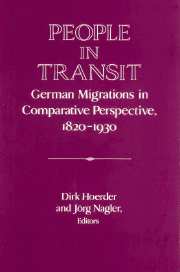Book contents
- Frontmatter
- Introduction
- PART I CONTINUITY AND COMPLEXITY: MIGRATIONS FROM EAST ELBIAN GERMANY AND GALICIAN POLAND
- 1 German Emigration Research, North, South, and East: Findings, Methods, and Open Questions
- 2 Colonist Traditions and Nineteenth-Century Emigration from East Elbian Prussia
- 3 Overseas Emigration from Mecklenburg-Strelitz: The Geographic and Social Contexts
- 4 Emigration from Regierungsbezirk Frankfurt/Oder, 1815-1893
- 5 Preserving or Transforming Role? Migrants and Polish Territories in the Era of Mass Migrations
- Part II Internal German Migrations and In-Migrations
- PART III WOMEN'S MIGRATION: LABOR AND MARRIAGE MARKETS
- PART IV ACCULTURATION IN AND RETURN FROM THE UNITED STATES
- 18 Migration Past and Present - The German Experience
- 19 Research on the German Migrations, 1820s to 1930s: A Report on the State of German Scholarship
- Index
2 - Colonist Traditions and Nineteenth-Century Emigration from East Elbian Prussia
Published online by Cambridge University Press: 05 January 2013
- Frontmatter
- Introduction
- PART I CONTINUITY AND COMPLEXITY: MIGRATIONS FROM EAST ELBIAN GERMANY AND GALICIAN POLAND
- 1 German Emigration Research, North, South, and East: Findings, Methods, and Open Questions
- 2 Colonist Traditions and Nineteenth-Century Emigration from East Elbian Prussia
- 3 Overseas Emigration from Mecklenburg-Strelitz: The Geographic and Social Contexts
- 4 Emigration from Regierungsbezirk Frankfurt/Oder, 1815-1893
- 5 Preserving or Transforming Role? Migrants and Polish Territories in the Era of Mass Migrations
- Part II Internal German Migrations and In-Migrations
- PART III WOMEN'S MIGRATION: LABOR AND MARRIAGE MARKETS
- PART IV ACCULTURATION IN AND RETURN FROM THE UNITED STATES
- 18 Migration Past and Present - The German Experience
- 19 Research on the German Migrations, 1820s to 1930s: A Report on the State of German Scholarship
- Index
Summary
Modern history, which is characterized by the genesis and development of capitalism, witnessed numerous and diverse regional, national, and international migrations. These migrations differ in their dominant motives, their scope, their origins and destinations, their structure, forms, and organization. They took place simultaneously, consecutively, or flowed into each other within a certain geographical space. In their totality, their relationships to each other and to their underlying social contexts, such migrations constitute the subject matter of historical migration research.
Rostock University is home to a research project on the history of East Elbian migration during the nineteenth century. The project is investigating different streams of migration and their historical interrelationship in certain territories. It is concentrating on migrations varied in direction, structure, intensity, duration, and scope, from selected small areas, namely, county, town, districts of the landed nobility (Gutsbezirke), and village. These migrations are considered in their relationship to each other, to the underlying social conditions, and to migration traditions in each historical area. The participants in this project essentially use the same archival basis and the same research methods and cover the following regions in their studies: Mecklenburg, Pomerania, and Brandenburg. These regions were selected because they constitute a coherent research area. Other criteria that led to this choice, and thus opened up the possibility of a comparative study of nineteenth-century East Elbian migration, include a substantial archival base, the significance of these areas in the overall migration process, and similar socioeconomic conditions among them.
- Type
- Chapter
- Information
- People in TransitGerman Migrations in Comparative Perspective, 1820–1930, pp. 35 - 56Publisher: Cambridge University PressPrint publication year: 1995

